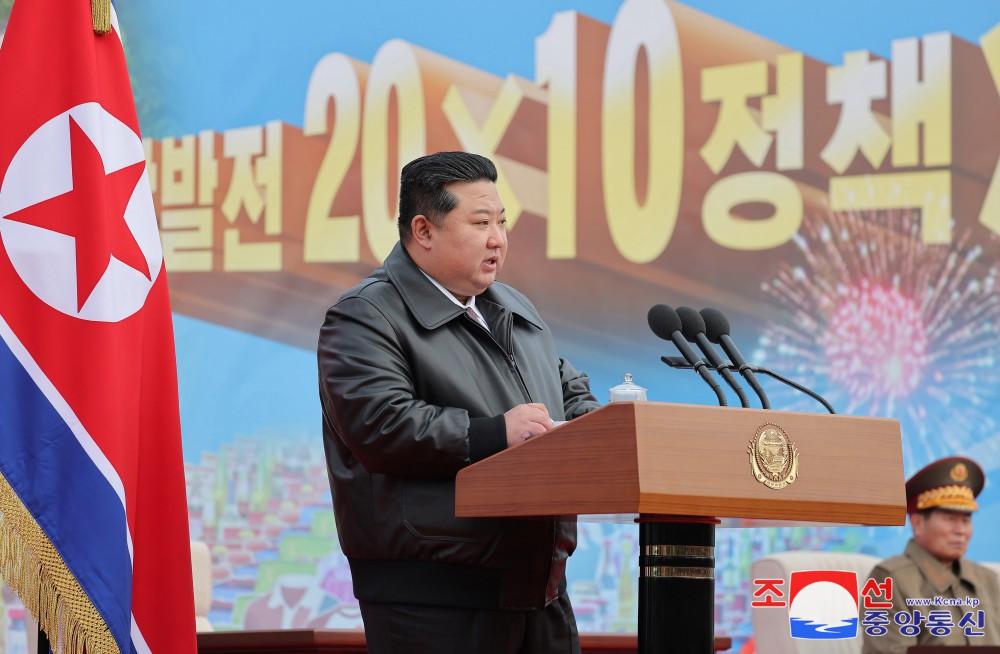الأخبار
U.S.-Japan-South Korea Information Sharing under Fire

U.S.-Japan-South Korea Information Sharing
under Fire
Pyongyang, May 25 (KCNA) -- Kang Jin Song, an international affairs analyst,
released the following article under the title "The establishment of the U.S.-
Japan-south Korea tripartite information-sharing system will lead to tripartite
sharing of crisis" on May 25:
The U.S., Japanese and south Korean chief executives met in Hiroshima on May
21 to discuss new sinister measures for tightening their military cooperation,
talking about the DPRK's "threat and provocation".
In the "brief talks" that took only less than two minutes, the hostile forces
discussed the tripartite security cooperation such as "the real-time sharing of
north Korean missile alert information."
It is a well-known fact that nine years ago the U.S. cooked up the Tripartite
Information Sharing Agreement (TISA) by pressurizing Japan and south Korea,
thus officially instituting the triangular cooperation in the military field for the first
time.
The U.S. has given top priority to the sharing of military information on the DPRK
in strengthening the tripartite military cooperation and has steadily pushed
forward with it. Recently, it has underpinned behind the scene the restoration of
the Japan-south Korea General Security of Military Intelligence Agreement
(GSOMIA) which was on the verge of abrogation.
However, it is impossible to ensure the real-time tracking of movements of the
strategic rivals in Northeast Asia with TISA, which allows the sharing of
information only via the U.S, and with GSOMIA, which allows only requested
exchange of information. This is a trouble of the U.S.
The U.S., for this reason, seeks to connect the command and control systems of
the U.S. forces in Japan, the U.S. forces in south Korea, the "Self-Defense
Forces" of Japan and the south Korean forces to its Indo-Pacific Command and
thus build a system for real-time sharing of military information.
The U.S., Japanese and south Korean chief executives were committed to the
real-time sharing of missile alert information in Phnom-Penh of Cambodia in
November last year and recently reaffirmed it again. This goes to prove that the
project for establishing a tripartite information sharing system is being pushed
forward at the final stage.
Recently floating is the rumor that the U.S., Japanese and south Korean defense
authorities would finally conclude an agreement on tripartite information sharing
on the occasion of the Shangri-La Dialogue to be held in early June. This is not
fortuitous.
What is the aim sought by the U.S. in pushing forward with the establishment of
the tripartite information sharing system with Japan and south Korea on a top
priority basis?
In recent years the U.S. has lavished its investment on forming the triangular
military alliance between the U.S., Japan and south Korea, an "Asian version of
NATO", in Northeast Asia which is of core military strategic significance in
carrying out its Indo-Pacific strategy.
The ever more frequent deployment of the U.S. strategic assets in Northeast
Asia and the U.S.-Japan-south Korea joint military exercises are taking place at
the level of the military alliance.
In particular, the U.S. president called the south Korean chief executive to the
White House in April to declare the establishment of the "nuclear consultative
group" and even Japan is planning to take part in it. This proves that the
triangular military cooperation between the U.S., Japan and south Korea will
soon be shaped into a NATO-style nuclear cooperation alliance.
Furthermore, such new function as real-time tripartite sharing of information will
be added to the cooperation, which means the emergence of the actual U.S.-
Japan-south Korea military alliance with the single nerve centre in Northeast
Asia.
The master and its stooges, hell-bent on pursuing hegemony, overseas
expansion and confrontation with the DPRK, work hard to acquire integrated
military information images without any blind spot in the Asia-Pacific region
including Northeast Asia. It is as clear as noonday for what purposes they will be
used.
Military and political blocs of exclusive and confrontational nature such as
AUKUS, Five Eyes and QUAD, the products of the U.S. ill-minded divisive
military and foreign policy, are now located more densely in the Asia-Pacific
region than any other regions, exposing peace and security of mankind to grave
threats.
Another military alliance is to appear in the region where the confrontation
between powers is escalating. This further stirs up the international community's
uneasiness and concern.
Moreover, the military bloc with such extremely dangerous perfect multiple
functions as NATO-style multi-party nuclear cooperation and real-time sharing of
military information will appear just in Northeast Asia. This is heightening the
vigilance of regional countries including the DPRK to the maximum.
The U.S. vicious scenario for confrontation is the most serious threat to global
peace and security as it seeks to invent a "pretext" for fabricating the U.S.-Japan-
south Korea military bloc by violating the inviolable security of the DPRK and to
secure its military edge in the Asia-Pacific region by cooking up the "Asian-
version NATO."
The DPRK and the righteous international community will never tolerate the anti-
peace grouping by the U.S. and its followers but frustrate the hostile forces'
wrong choice step by step with powerful strength.
The U.S. and its followers will get more and more exposed to security crisis
facilitating its final ruin for its frantic moves to tighten their military alliance against
the DPRK and expand the war drills for aggression. This is an equation
characterizing the present dynamic structure of the Korean Peninsula.
If the U.S. and its stooges add a new variable called the tripartite information
sharing system to this invariable equation, crisis sharing, instead of information
sharing, will turn out as a functional value. -0-



















